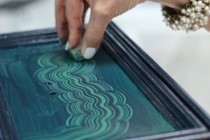After choosing a color, you may be so eager to see your color on the walls, that you’re tempted to rush ahead and roll it on. By skipping important steps, you can drastically affect how your finished paint job looks. Use these tips the next time you’re painting to pall off that gorgeous paint finish!
Tips for a Flawless Paint Finish
Draped and Taped
If you skip this step, you’ll spend extra time removing drip marks, spatters and smudges
- Remove or cover any furniture, light fixtures, vent covers and outlet covers.
- Mask off any trim or any other surfaces not receiving paint.
- Protect flooring by laying down a canvas drop cloth. Push furniture to the center of the room and cover with plastic tarps.
Smooth and Clean
The last thing you want is to be distracted by flaws instead of admiring your finished paint job. So remember this:
- Fill it – Fill in cracks, dings and surface imperfections with spackle and a putty knife. Let it dry and sand lightly until you can’t feel any ridge at the edge of the patched area. If you find old paint drips, or uneven spots on the wall, sand those smooth too.
- Sand it – Uneven color, bubbling or peeling paint usually develop when you paint over a dirty surface or painting over a semi-gloss or high-gloss finish without sanding. So, use a fine grit sandpaper and lightly scuff up any glossier surfaces. Paint adheres better to rough surfaces than smooth ones.
- Clean it – You also want to clean the surface. Use water and ammonia or a detergent like Mr. Clean, then rinse with plain water to remove residue from the cleaner. Or, use a wall cleaner like tri sodium phosphate (TSP) to remove grime and gloss without leaving a residue. Let everything dry completely before working with the surface again.
Primed and Ready
Primer helps you get even paint color. If you’re using a paint and primer in one, you can usually skip this – check the label to be sure. Whichever product you choose, here are three reasons why primer is important to your finished results:
- Patches will show – Unless you use a self-priming patch product, spackle will absorb paint differently causing spot discoloration.
- Coverage – If you’re painting over deep colors, designs, or if you tested different colors on the wall, they can show through your new color. You could spend extra time and money rolling on more coats of paint to cover an old finish.
- Stains – Some types of heavy stains or watermarks can show through your layers of paint.
Finishing Touches
Matte and glossy finishes reflect light differently and they hold up differently to wear-and-tear and washing. So keep these tips in mind:
- Flat – Ideal for low-traffic areas. Matte appearance shows a color’s “true hue.” If your wall has lots of imperfections, flat finishes will help conceal them.
- Eggshell – Smooth, washable finish with a very slight sheen. Ideal for living rooms, hallways, bedrooms and dens.
- Satin – Popular for most rooms because it’s a bit more washable than eggshell, with similar sheen, but still stays very true to the color.
- Semi-gloss – This glossier finish stands up well to washing, so it’s ideal for bedrooms, kitchens and children’s rooms. Your color will appear a touch more vivid because of light reflection with the sheen.
- Gloss – The highest shine of any finish. It’s very washable so glossy finishes are well-suited for trimwork, doors and windows and high-traffic spots. Flaws will show, so proper prep is important. Also a great choice to add a touch of glamour because colors appear more vivid in this sheen and surrounding colors will be reflected as well.
Tools
Compared to low-quality products, quality brushes and rollers will help you get even color with less work. Here’s how:
- Premium roller covers will hold more paint without dripping and spattering.
- You’ll use less paint to get even coverage and you’ll have fewer trips back and forth to the paint tray.
- The same goes with good brushes. They apply paint more smoothly, requiring fewer layers to conceal brushstrokes.
- Higher quality rollers and brushes resist “shedding” and last longer.
Technique
When painting with a roller, your goal is to lay the paint on the surface evenly and overlap the edges of each painted section so no ridges, thin spots or uneven coloring shows through. Here are some essentials to help you hit the mark:
- Work in three- to four-foot square sections. This also works as a guide for “roller loading.” Reload your roller after you finish each section.
- Work in a zig-zag pattern. Paint on in a “W” pattern to fill in a section. Finish with horizontal strokes and then vertical strokes.
- Overlap the edges of each section. This helps blend the edges of one painted area with the next.
- Repeat. For truest color, two coats are almost always recommended.
For more tips and advice, go to Tips.acehardware.com.
Published: 3/5/2020




